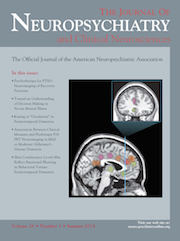Divalproex Sodium and Quetiapine Treatment of a Pedophile With Bipolar Spectrum Disorder
To the Editor: Pedophilic disorder is a psychiatric disorder diagnosed in adults or adolescents, 16 years of age or older, having intense sexual urges and behaviors focused on sexual activity with prepubescent children at least 5 years younger. It leads to distress or interpersonal difficulty. Psychiatric comorbidity rates in pedophilia are high and require careful consideration during evaluation and drug treatment. Almost 60%‒70% of reported patients with pedophilia had a history of mood and anxiety disorders.1 Currently, there is no effective way to cure pedophilia; however, antiandrogen drugs and gonadotropin-releasing hormone analogs are used to reduce libido in an attempt to reduce or prevent pedophilic behaviors or child abuse.2 Here, we report a case of a male patient with pedophilia and bipolar spectrum disorder who responded to combination treatment with divalproex and quetiapine.
Case Report
A 25-year-old unmarried man was referred for the treatment of depression and pedophilia. During the outpatient following visits, he admitted that for several years he had obsessive thoughts and was preoccupied with fantasies about and sexual urges toward his 7-year-old niece. Moreover, he had watched and collected films on prepubescent child pornography from the internet to masturbate about three times each week. Eventually, he could not control his fantasies and tried to rub against his niece to the point of orgasm. The above symptoms interfered with his daily life in terms of losing his job, socializing with family and friends, and quality of sleep. Initially, he was given sertraline, 25 mg/day over an 8-week period. Dramatically, he reported effective alleviation of the depressive symptoms, but he chose to stop medication because of no effect on pedophilia. However, 6 months later, he experienced elated mood, inflated self-esteem, flight of ideas, decreased need for sleep, purchasing sprees, increased sexual motivation, and excessive involvement in pleasurable activities. This lasted for less than 4 days, and there was no severe impairment of social or occupational function. He was subsequently started on divalproex sodium and quetiapine, and the dosage was titrated to 1500 mg/day and 100 mg/day in 8 weeks, respectively. The mood symptoms were completely resolved and obsessive sexual thoughts further improved over the course of another 8 weeks. He continued to be compliant with divalproex sodium and quetiapine, with near-complete resolution of pedophilic symptoms. During the last outpatient visits (maintenance treatment), he was able to return to his previous job and maintain a fair social role at his workplace and home.
Discussion
To our knowledge, this is the first report of pedophilia with bipolar spectrum disorder that responded to the combination treatment of divalproex and quetiapine. Initially, low sertraline (serotonin reuptake inhibitor) dose was used to treat this patient. Unexpectedly, he experienced subthreshold hypomania symptoms followed by a subsequent depressive episode; therefore, he briefly stopped taking sertraline.
Differentiating hypomanic phase symptoms from repetitive behavioral sexual impulsivity and indiscretion is difficult. High comorbidity rates of axis I psychiatric disorders should be taken into account. Interestingly, pharmacological treatments of axis I comorbidities can alleviate both sets of disorders.3 We prescribed divalproex sodium and quetiapine to primarily relieve mood symptoms. After the improvement of bipolar symptoms, his pedophilic behaviors were reduced and normal daily life was restored. It was implied that quetiapine (an antipsychotic with both serotonin and dopamine receptor-blocking properties) could have some effects on paraphilic symptoms. Dopaminergic neurotransmission may contribute to the etiology of pedophilia because there is an association between obsessiveness and structural changes in the nucleus accumbens, an area that plays an important role in reward processing4,5 as has been described. Quetiapine augmentation therapy may be effective for pedophilia, except for modulation of mood symptoms. We cannot exclude a placebo effect on our patient; however, this drug combination provides an alternative pharmacological treatment for pedophilic patients with comorbid bipolar spectrum disorder.
1 : Psychiatric comorbidity in pedophilic sex offenders. Am J Psychiatry 1999; 156:786–788Medline, Google Scholar
2 : Effect of a long-lasting gonadotrophin hormone-releasing hormone agonist in six cases of severe male paraphilia. Acta Psychiatr Scand 1993; 87:445–450Crossref, Medline, Google Scholar
3 : Axis I psychiatric disorders, paraphilic sexual offending and implications for pharmacological treatment. Isr J Psychiatry Relat Sci 2012; 49:255–261Medline, Google Scholar
4 : Structural brain abnormalities in the frontostriatal system and cerebellum in pedophilia. J Psychiatr Res 2007; 41:753–762Crossref, Medline, Google Scholar
5 : Reward deficiency syndrome: genetic aspects of behavioral disorders. Prog Brain Res 2000; 126:325–341Crossref, Medline, Google Scholar



